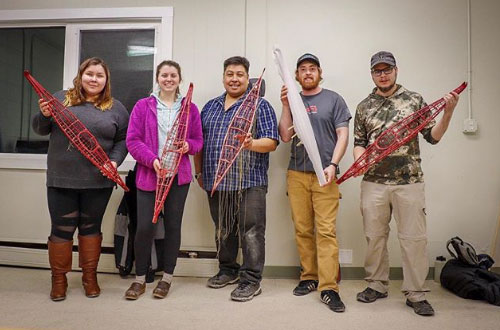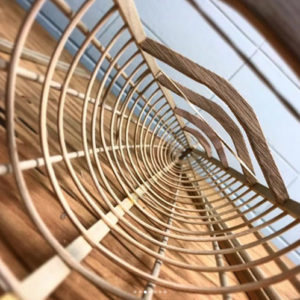 Photos courtesy of Matt Allen
Photos courtesy of Matt Allen
Traditionally, kayak building was a rite of passage for young Alaska Native boys, a process that would mark the transition from boyhood to manhood. For a handful of Alaska Pacific University students, it’s also been the focus of a one-of-a-kind block course.
Over the course of three weeks, Andrew Abyo coached his students through the finer points of kayak building — from maneuvering the backsaw to make more precise cuts to measuring angles so the finished product is visually pleasing — as well as lectured on folklore, traditional games, and Alaska Native culture.
Though the class built model-sized vessels, the fundamentals and process for a full-sized boat are the same. With $400 for supplies and a few weeks of labor, students could theoretically build their own seaworthy watercrafts.
The steps, Abyo said, are simple. Start with the gunnels and one spacer in the middle. Here it’s flexible reeds and rubber bands, but a full-sized craft would use yellow cedar and rope. Step two sees the addition of deck beams, and steps three and four add the bow and stern. From there, it’s the adding of the keel, ribs, and a coat of red paint.
“These were traditionally viewed as a living being, so the red represents blood,” Abyo explained. “There would also be a line carved throughout and that was the lifeline.”
Finally, they add the skin and raincoat. Though traditionally walrus, seal or sea lion, for the class, they used a synthetic material.
“To the animals in the water, it looks like another animal,” Abyo said.
Making of a craftsman
Abyo, now 47, didn’t start doing kayak building until he’d attended a culture camp in 2008.

Some of those kayaks were for himself or for his children. Others were made at culture camps and are owned by the corporation behind the camp. For a few years, one of Abyo’s kayaks even hung in the Anchorage Bass Pro Shop, though it’s since been moved to the company’s main headquarters.
“This has been such a journey,” Abyo said. “It wasn’t on my radar — I grew up commercial fishing and never thought about doing this kind of art. My uncle did Native art shows and I’d think ‘wow, I wish I could do that,’ but I never tried. Took one of his classes and realized it was natural inside me.”
Now he’s renowned for the detail and authenticity of his work. Beyond kayaks, Abyo makes Alutiiq bentwood visors, atlatls, harpoons, paddles, and baidarka carvings. His work is featured in museums and Alaska Native corporations across that state and as far away as a museum in Hokaido, Japan.
Abyo said he views his craft as a way to pass cultural knowledge onto the next generation and allows for another medium to promote more cultural understanding.
“I get asked all the time, ‘Do I need to be Native to learn this?’” Abyo said. “I tell them, ‘No, you just need the desire to know more about all cultures.’ I’ll happily teach anyone about my culture if they want to learn.”
